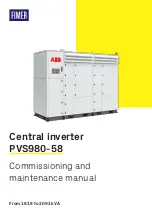
2
−
4
T-343
2.3.3 Post-Start Inspection
a. Allow the Genset unit to run for at least 2 minutes.
b. Turn on CB-1 for 460 volt units.
c. Check generator output with a voltmeter. In the no
load condition, output should be at 490 (+/- 15 volts)
with 1800 engine RPM.
d. Start refrigeration unit.
e. Run engine 10 minutes (check total time meter op-
eration).
f. Listen for abnormal bearing noise (AC generator).
g. Check fuel lines, lube oil lines, and filters for leaks.
h. Check exhaust system for leaks.
2.3.4 Stopping Instructions
a. Place CB-1 in the OFF position.
b. Place the ignition switch in the
OFF position.
2.4 SEQUENCE OF OPERATION
WARNING
Beware of moving poly V-Belt and belt
driven components.
a. Standard Units:
With the intake heater switch (HS) held in the ON
position, current flows through the ammeter to the
intake heater. While the heater is on, the ammeter will
show a 42
−
amp draw.
A second set of contacts also energizes the safety relay
(S).
If the high water temperature switch (HWT) opens to
break the safety relay ground connection, the safety
relay will not energize, and the engine will not start.
To start the engine, the ignition switch (IGN) is held in
the START position. With the switch in the START
position, current flows to the start solenoid (SS), through
the SS contacts to the starter motor (SM). Current then
flows to the intake heater timer, intake heater relay (HR)
and to the heater, while simultaneously powering the
electronic governor module (EG), fuel solenoid (FS),
and engine speed sensor (ESS).
The starter motor turns over the engine resulting in
pumping of fuel to the engine cylinders by the injection
pump. This fuel is ignited by heat of compression; thus
starting the engine. When the engine has developed
sufficient oil pressure, the low oil pressure switch (LOP)
contacts close to maintain power to the safety relay (S).
Once the engine has started, the intake heater (IH) will
remain energized for 3 minutes.
The ignition switch (IGN) will be released. The intake
heater switch (HS) will be held for 5 seconds, then
released after the ignition switch is released. When the
START switch is released, the starter will be
disengaged.
With the engine running, the battery charger provides
DC power to operate the control system and charge the
battery.
b. Units with Auto Start, Low Coolant Sensor:
When the ignition switch (IGN) is placed in the RUN
position, 12-volt DC power is applied to the low coolant
sensor (LCS), if applicable, and the auto restart module
simultaneously. If the coolant level is below the sensor,
all the indicator lights on the auto restart module will
blink once and the LCS will open the contacts on the low
coolant relay, de-energizing the unit’s 12-volt DC
circuitry. If the coolant level is above the sensor, the auto
restart module will maintain power and all lights on the
module will illuminate. As the auto restart module
performs its self test, the lights will go out individually.
After the self test is complete, the auto restart module
will energize the intake heater and sound the audible
alarm warning, indicating that the unit has been
powered on and will start. The 30
−
second delay starts at
this time. When the 30
−
second delay expires, power will
be applied to the electronic governor and the engine
attempts to crank for 15 seconds.
When the engine starts, the intake heater will remain
energized for 3 minutes; during this time, the
engine/intake heater light and alarm will be energized,
the shutdown/lockout time delay of 15 seconds will
begin counting, and the starter will be disengaged.
During the shutdown/lockout time delay at start up, the
auto restart module will disregard the signals to the oil
pressure and engine temperature inputs, and the Run
sequence will begin. If engine does not start, refer to
Table 1.3 for auto restart sequencing.
c. Units with Dual Speed Option:
When the Operating Mode switch is placed in the
POWER position, the engine will run continuously at
1800 RPM, 60 Hz (normal operating mode).
When the Operating Mode switch is placed in the
ECONOMY position, 12
−
volts DC will be supplied to the
Dual Speed Timer (DT). The timer will pass 12
−
volts DC
to Electronic Governor Module (EG) via pin #15 after a
period of two (2) hours. The power to pin #15 will signal
the control logic within the EG to throttle the engine to
1500 RPM, 50 Hz operation.















































